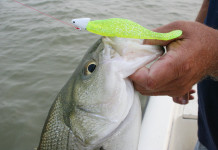Texas bass fishing is living large.
And that’s not just lip service about the bucketmouth fish that have become the top angling target not only across the state but also the country.
Bassmaster magazine last year released its list of the best 100 U.S. bass lakes and Texas led the way with eight selections. Florida, generally regarded as the bastion for big bass and the namesake for the strain of fish that has spurred the bass bounty, landed six lakes on the list. The selections were narrowed using creel survey data, tournament catch figures and fish stocking efforts, among other information.
Falcon Reservoir, the 80,000-acre Goliath of a lake shared with Mexico and nestled on the Rio Grande near Zapata was tabbed No. 1, while another border lake, Amistad Reservoir near Del Rio, came in at No. 6. Other state bodies of water that made the list are Toledo Bend (No. 15), Sam Rayburn (No. 19), Fork (No. 26), Choke Canyon (No. 39), Conroe (No. 64) and O.H. Ivie (No. 88).
The Texas bodies of water are situated in a variety of locales and climates, but all feature one similarity – excellent habitat for spawning and ambushing prey – the things bass do best. Each lake has produced numerous entries 13 pounds or larger into the ShareLunker program, a selective breeding effort by the Texas Parks and Wildlife Department that ultimately is aimed at eclipsing the state record largemouth of 18.18 pounds. That fish was caught from Lake Fork, which has produced 32 of the state’s 52 heftiest largemouths, but recently has tailed off somewhat in its ShareLunker frequency that had been a frenetic pace.
Texas’ bass fishing success rests almost solely on the efforts of fisheries biologists, who in the early 1970s began producing and stocking Florida largemouth fingerlings. Those fledgling efforts have amped up into mass production – TPWD stocked 11.5 million Florida largemouth fingerlings across the state last year – and the big bass craze only will continue to expand.
Another significant role in the big bass output has been played by Mother Nature – specifically her impact on water levels during prolonged drought and accompanying vegetation growth. A classic example is O.H. Ivie, which was hit hard by drought during the early to mid-1990s and into the 2000s. As reservoir levels plummeted, brush and other cover grew into the bottom, which in turn harbored excellent habitat when water levels rose. In recent years the body of water east of San Angelo is among those that has caught fire in the big bass haul, producing 11 ShareLunker fish above 13 pounds from January to April in 2010 alone. The reservoir again is dangerously low, but it’s likely that even decent rains will work wonders to help it bounce back.
The work of fisheries biologists hasn’t gone unnoticed but one glaring certainty is the fact that it has been two decades since the state record largemouth was landed. The state largemouth standard was eclipsed in 1980 with a fish just over 14 pounds and as the stocking efforts intensified the record was topped again and again until the current mark was reached. Biologists have done a first-class job of making sure that almost every region of the state has been stocked with a burgeoning surplus of bass, but perhaps it’s time to look west for one example of what it may take to top the most hallowed of fishing records.
California is blessed with the title of big bass capital of the world due in large part to the stocking of a complementary species – one that Texas biologists also introduce each year into state waters. On the list of the 25 heaviest U.S. largemouths, 20 have been landed in California, including its state record of 21 pounds, 12 ounces. In many California lakes bass feed primarily on stocked rainbow trout, which are fat, slow and dumb. These easy prey targets ensure that gluttonous bass don’t ever go hungry and they essentially just swim and eat until they can’t anymore.
The classic example of this scenario is Lake Dixon, which sits just east of Escondido. The 70-acre body of water is diminutive to say the least but is relatively deep and harbors gargantuan largemouths, including a 25-pound fish caught in 2006. However, that fish was foul-hooked and would not have been eligible for entry into the International Game Fish Association record books. The longstanding IGFA largemouth record is a 22.4-pound fish caught by George Perry in 1932 at Montgomery Lake in Alabama.
Perhaps TPWD should invest more time and energy into mirroring what California has had success with. There are numerous small lakes in Texas but finding the right mix of favorable habitat could be a chore. TPWD primarily stocks rainbows to ensure community lake fishing success but there’s no doubt that those fish also are the perfect meal and possibly the golden ticket for growing even bigger bass.
The department stocks a massive number of largemouth fingerlings each year, but the number of stocked rainbows is a fraction by comparison. The trout that are put into lakes are older and larger, taking more time to nurture, but TPWD only stocked about 290,000 last year statewide. If the production of rainbows was increased and concentrated in even a handful of smaller lunker largemouth lairs it’s a good bet that within a few years there could be a bass tickling or even surpassing the 18-pound mark.
Fisheries biologists have done nothing short of outstanding and prolific work in creating a sustainable bass fishery that is light years ahead of what it was even a generation ago. There’s no doubt their tireless efforts will continue, which is a great thing for all of us, but maybe it’s time to look at other avenues in the quest to help some lucky angler latch onto a fish of a lifetime.
And a record one, too.






















